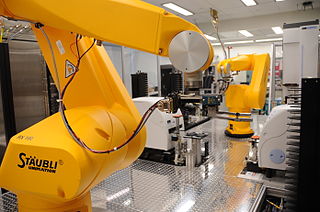Drug discovery depends on methods by which many different chemicals are assayed for their activity. These chemicals are stored as physical quantities in a chemical library or libraries which are often assembled from both outside vendors and internal chemical synthesis efforts. These chemical libraries are used in high-throughput screening in the drug discovery hit to lead process. [1]

In the fields of medicine, biotechnology and pharmacology, drug discovery is the process by which new candidate medications are discovered.
A chemical library or compound library is a collection of stored chemicals usually used ultimately in high-throughput screening or industrial manufacture. The chemical library can consist in simple terms of a series of stored chemicals. Each chemical has associated information stored in some kind of database with information such as the chemical structure, purity, quantity, and physiochemical characteristics of the compound.
Chemical synthesis is the artificial execution of useful chemical reactions to obtain one or several products. This occurs by physical and chemical manipulations usually involving one or more reactions. In modern laboratory uses, the process is reproducible, reliable, and established to work the same in multiple laboratories.
Contents
The chemical libraries in larger pharmaceutical companies are a critical part of the discovery process. These chemicals are stored in environmentally controlled conditions in small or large containers, often labeled with codes that pass back into a database. Each chemical in the storage bank must be monitored for shelf life, quantity, purity and other parameters, and its banked location. In some companies, the compounds can also include biological compounds, such as purified proteins or nucleic acids. The management of these chemical libraries, including renewal of outdated chemicals, databases containing the information, robotics often involved in fetching chemicals, and quality control of the storage environment is called Compound Management or Compound Control. Compound Management is often a significant expense, as well as career for one or more individuals who manage a chemical library at a research site. [2]
There are many books and journal articles devoted entirely or in part to compound management. [3] It has become a critical technological component for high-throughput screening and chemical genomics. There are great challenges to be faced in the necessity of compound management, which are being surmounted by concerted efforts in the public and private domain. [4] In 2008, authors at the National Institutes of Health's Chemical Genomics Center have released a paper showing the necessity of a highly automated, reliable and parallel compound management platform, in order to serve over 200,000 different compounds. [5]

The National Institutes of Health (NIH) is the primary agency of the United States government responsible for biomedical and public health research. It was founded in the late 1870s, and is now part of the United States Department of Health and Human Services. The majority of NIH facilities are located in Bethesda, Maryland. The NIH conducts its own scientific research through its Intramural Research Program (IRP) and provides major biomedical research funding to non-NIH research facilities through its Extramural Research Program.
In short, Compound Management requires inventory control of small molecules and biologics needed for assays and experiments, especially in high-throughput screening. It utilizes knowledge of chemistry, robotics, biology, and database management. The manager must also be acutely aware of safety standards in the handling and storing of radioactive, volatile, flammable and unstable compounds. Often, in large pharmaceutical companies, the chemical and biological compounds contained in compound libraries can number in the millions, making compound management and compound control important contributors to research and drug discovery.

High-throughput screening (HTS) is a method for scientific experimentation especially used in drug discovery and relevant to the fields of biology and chemistry. Using robotics, data processing/control software, liquid handling devices, and sensitive detectors, high-throughput screening allows a researcher to quickly conduct millions of chemical, genetic, or pharmacological tests. Through this process one can rapidly identify active compounds, antibodies, or genes that modulate a particular biomolecular pathway. The results of these experiments provide starting points for drug design and for understanding the noninteraction or role of a particular location.

Chemistry is the scientific discipline involved with elements and compounds composed of atoms, molecules and ions: their composition, structure, properties, behavior and the changes they undergo during a reaction with other substances.

Robotics is an interdisciplinary branch of engineering and science that includes mechanical engineering, electronic engineering, information engineering, computer science, and others. Robotics deals with the design, construction, operation, and use of robots, as well as computer systems for their control, sensory feedback, and information processing.






